Decloux, Marcel Auguste (Flying Officer)
Killed in Action 1944-January-16
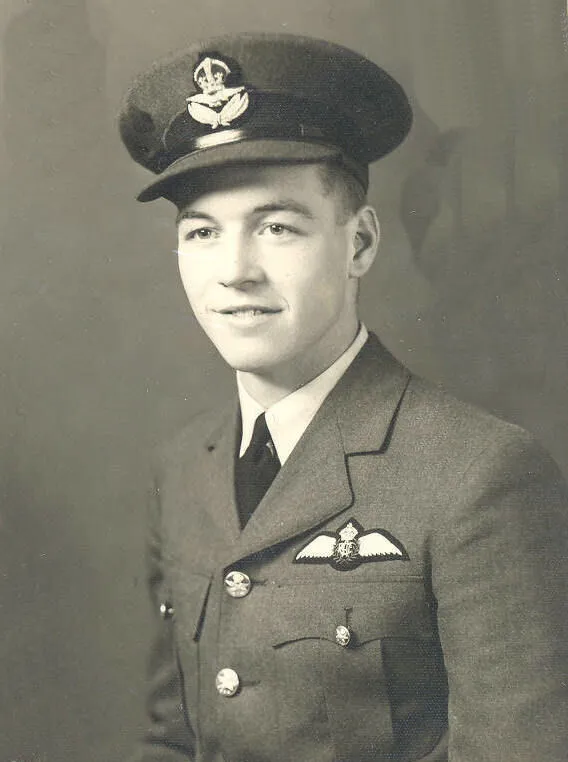

Birth Date: 1923-June-12
Born: Winnipeg Manitoba
Parents: Justin & Pauline Decloux, Toronto, Ontario
Spouse:
Home: Winnipeg, Manitoba
Enlistment:
Enlistment Date: unkown date
Service
RCAF
Unit
404 Sqn- Squadron
Ready to Fight
Base
RAF Thorney Island
Rank
Flying Officer
Position
Pilot
Service Numbers
J/14440
Home
Beaufighter serial: LZ296

Bristol Beaufighter, coded PN-B.
The Bristol Type 156 Beaufighter (often referred to simply as the "Beau") was a multi-role aircraft developed during the Second World War in the UK. It was originally conceived as a heavy fighter variant of the Bristol Beaufort bomber. Upon its entry to service, the Beaufighter proved to be well suited to the night fighter role, for which the RAF initially deployed the type during the height of the Battle of Britain, in part due to its large size allowing it to accommodate both heavy armaments and early airborne interception radar without major performance penalties.
As its wartime service continued, the Beaufighter was used in many different roles; receiving the nicknames Rockbeau for its use as a rocket-armed ground attack aircraft, and Torbeau in its role as a torpedo bomber against Axis shipping, in which it came to replace the Beaufort which had preceded it. In later operations, it served mainly as a maritime strike/ground attack aircraft, RAF Coastal Command having operated the largest number of Beaufighters amongst all other commands at one point.
The Beaufighter saw extensive service during the war with the RAF (59 squadrons), Fleet Air Arm (15 squadrons), RAAF (seven squadrons), RCAF (four squadrons), USAAF (four squadrons), RNZAF (two squadrons), SAAF (two squadrons) and the Free Polish Air Force (one squadron). In addition, variants of the Beaufighter were also manufactured in Australia by the Department of Aircraft Production (DAP), often called the DAP Beaufighter. n the fall of 1940, Luftwaffe bombers, unable to escape Allied fighters by day, started flying night missions, where they would encounter much less opposition. Immediately, the Allies prepared their response: the improvement of interception radars used in ground controls, the use of twin-engine Bristol Beaufighters as night-fighter aircraft, and the development of the Mk. IV airborne interception radar. Faster than a Junkers Ju 88, the Beaufighter displayed impressive firepower. Three RCAF squadrons were involved in night fighter operations, Nos. 406, 409 and 410, created in the spring and summer of 1941. Harold Skaarup web page with revisions
Unit Desciption
404 Sqn Ready to Fight ("Buffalo")
History of the Squadron during World War II (Aircraft: Blenheim IV, Beaufighter IIF, XC, XIC, Mosquito PR Mk VIC)
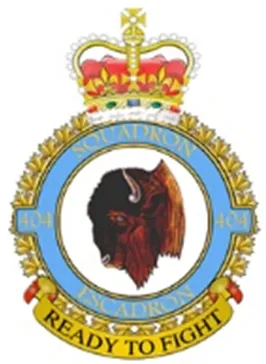
The squadron formed as the RCAF’s second, and first coastal, squadron formed overseas in WWII. It was a Coastal Fighter unit, formed at Thorney Island, Hampshire, UK ![]() in April 1941 as part of No 16 Group of RAF Fighter Command. Shortly after its formation, it moved to Scotland, where it spent most of the war, as part of No 18 Group Coastal Command. Initially the squadron was equipped with Bristol Blenheim Mk IV aircraft (unit code was EE). Its function was to attack enemy shipping along the Dutch and Norwegian coasts, and also later to provide long-range fighter cover for Coastal Command aircraft operating over the Bay of Biscay. The squadron flew from Castletown and Skitten, in Caithness, Scotland between July and October 1941, before moving to Dyce, Aberdeenshire, until December. In October “B†Flight of the squadron was based at Sumburgh in the Shetland Islands, and the remainder of the squadron joined them in December 1941. They were there until March 1942, when they moved to Dyce until August, when they returned to Sumburgh for 6 weeks. Then it was back to Dyce again until January of 1943. In September 1942 the squadron had re-equipped with Bristol Beaufighter IIF aircraft. In January 1943 the squadron moved to Chivenor in Devon as part of No 18 Group, and flew from there until they moved back to Scotland in April 1943, this time briefly based in Tain, Ross-shire before settling at Wick, where they remained until May 1944. From March to December 1943 they flew Beaufighters Mk XIC and then from September 1943 they flew the Mk XC. In early May 1944 the squadron moved to Davidstow Moor, Cornwall to assist with the D-Day landings. On the afternoon of D-Day itself, the squadron was involved in an action against 3 German destroyers which sought to intrude in the invasion fleet. They were equipped with rocket-firing Beaufighters and were part of a strike force that sank all three of the enemy ships. At the end of June 1944 they moved to Strubby, Lincolnshire, as part of No 16 Group, before returning to Scotland. This time they had a short stay at Banff, before moving to Dallachy, Moray, where they remained until April 1945 as part of the Dallachy Wing. They returned to Banff and were re-equipped with de Havilland Mosquito PR MK VIC aircraft, which flew as part of the Banff Wing
in April 1941 as part of No 16 Group of RAF Fighter Command. Shortly after its formation, it moved to Scotland, where it spent most of the war, as part of No 18 Group Coastal Command. Initially the squadron was equipped with Bristol Blenheim Mk IV aircraft (unit code was EE). Its function was to attack enemy shipping along the Dutch and Norwegian coasts, and also later to provide long-range fighter cover for Coastal Command aircraft operating over the Bay of Biscay. The squadron flew from Castletown and Skitten, in Caithness, Scotland between July and October 1941, before moving to Dyce, Aberdeenshire, until December. In October “B†Flight of the squadron was based at Sumburgh in the Shetland Islands, and the remainder of the squadron joined them in December 1941. They were there until March 1942, when they moved to Dyce until August, when they returned to Sumburgh for 6 weeks. Then it was back to Dyce again until January of 1943. In September 1942 the squadron had re-equipped with Bristol Beaufighter IIF aircraft. In January 1943 the squadron moved to Chivenor in Devon as part of No 18 Group, and flew from there until they moved back to Scotland in April 1943, this time briefly based in Tain, Ross-shire before settling at Wick, where they remained until May 1944. From March to December 1943 they flew Beaufighters Mk XIC and then from September 1943 they flew the Mk XC. In early May 1944 the squadron moved to Davidstow Moor, Cornwall to assist with the D-Day landings. On the afternoon of D-Day itself, the squadron was involved in an action against 3 German destroyers which sought to intrude in the invasion fleet. They were equipped with rocket-firing Beaufighters and were part of a strike force that sank all three of the enemy ships. At the end of June 1944 they moved to Strubby, Lincolnshire, as part of No 16 Group, before returning to Scotland. This time they had a short stay at Banff, before moving to Dallachy, Moray, where they remained until April 1945 as part of the Dallachy Wing. They returned to Banff and were re-equipped with de Havilland Mosquito PR MK VIC aircraft, which flew as part of the Banff Wing ![]() . The squadron was disbanded there in May 1945.
. The squadron was disbanded there in May 1945.
In the course of hostilities, the squadron flew some 3144 sorties, for the loss of 35 aircraft and 79 aircrew, of whom 77 were killed or missing. They were credited with destroying 8 aircraft, with 6 probables and 10 damaged. They dropped 32 tons of bombs on ships, 319 18-inch torpedoes and 1602 25-pound rockets, and were credited with 4 vessels sunk, 4 damaged, and had a share in 37 ships sunk and 14 damaged. They also shared in damaging 3 U-boats. The squadron members were awarded 2 DSOs, 45 DFCs, 3 Bars to DFC, 3 DFMs, 1 GM and 19 MiDs. Battle Honours were: Atlantic 1941–45, English Channel and North Sea, 1941–45, Baltic 1944–45, Normandy 1944, Biscay 1943–44. Wikipedia, Kostenuk and Griffin
Maps for Movements of 404 Squadron 1941-45
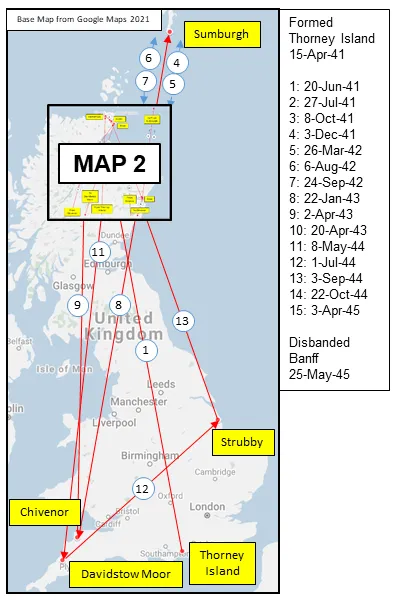
MAP 1: 404 Squadron Movements 1941-45 (right-click on image to display enlarged in new tab)
|
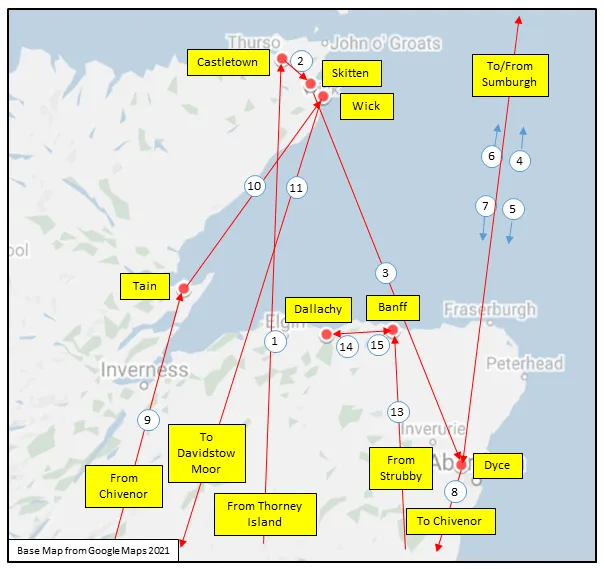
MAP 2: 404 Squadron Movements in Scotland 1941-45: Detail of Map 1
|
404 Sqn History Summary 1941-45
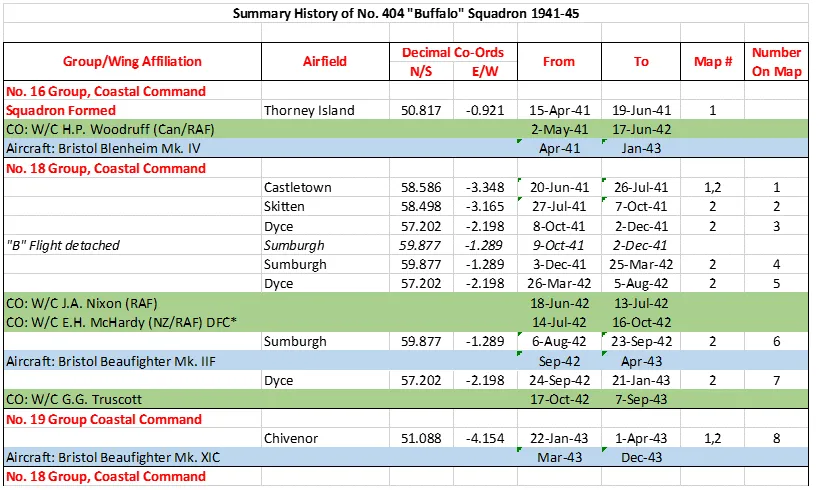
404 Sqn History Summary 1941-45 Page 2
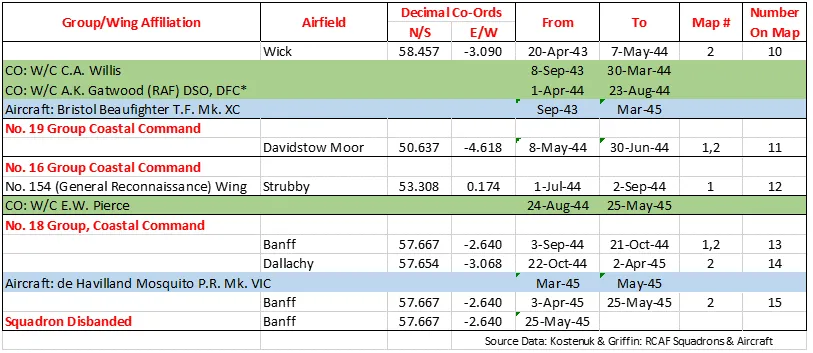
History of the Squadron Post-WWII (Aircraft: Lancaster X, Neptune, Argus I & II, Aurora)
The squadron was re-formed as No. 404 (Maritime Reconnaissance) Squadron at Greenwood, Nova Scotia ![]() on 30 April 1951, flying Avro Lancaster Mk. X aircraft. It was re-designated No 404 (Maritime Patrol) on 17 July 1956. The squadron was the second of four formed in Maritime Air Command, and flew on East Coast maritime duty. The aircraft used were Lancaster X until 1955, then Lockheed Neptune until 1960, then Canadair CP-107 Argus. On 1 February 1968 the squadron was integrated into the Canadian Armed Forces. Once the CP-140 Aurora aircraft became available, the squadron was designated 404 Maritime Patrol and Training Squadron. The current title is 404 Long Range Patrol and Training (LRP&T) Squadron, and it serves as the Operational Training Unit (OTU) for Aircrew and Maintenance personnel who work on the CP140 Aurora. It remains based at Greenwood, NS.
on 30 April 1951, flying Avro Lancaster Mk. X aircraft. It was re-designated No 404 (Maritime Patrol) on 17 July 1956. The squadron was the second of four formed in Maritime Air Command, and flew on East Coast maritime duty. The aircraft used were Lancaster X until 1955, then Lockheed Neptune until 1960, then Canadair CP-107 Argus. On 1 February 1968 the squadron was integrated into the Canadian Armed Forces. Once the CP-140 Aurora aircraft became available, the squadron was designated 404 Maritime Patrol and Training Squadron. The current title is 404 Long Range Patrol and Training (LRP&T) Squadron, and it serves as the Operational Training Unit (OTU) for Aircrew and Maintenance personnel who work on the CP140 Aurora. It remains based at Greenwood, NS.